The Family
One of the challenges that same-sex couples have to face is having children of their own. Although there are several ways they can accomplish it, none of them are easy. So when this couple from Omaha, Nebraska, decided to become parents, they realized how hard it would really be to make their dream come true. Luckily, someone very special in their lives decided to help them out in a great way.
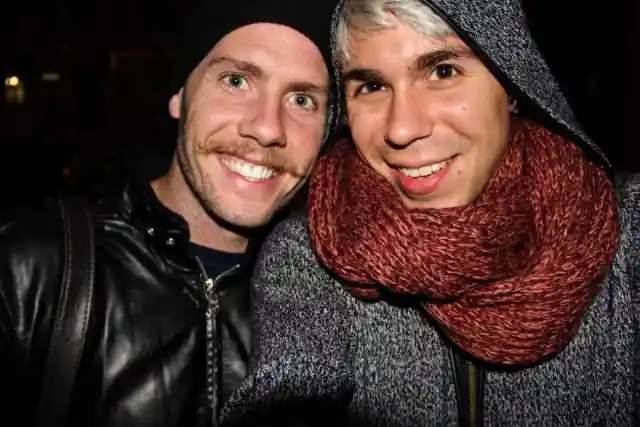

Matthew Eledge and Elliot Dougherty had been married for a while before they decided to have a baby. Just like any other person, Matthew told his mother, Cecile, about their plans. Cecile got very excited and it reminded her of the time when she became a mother herself. She had had such a wonderful time when she had Matthew that she desperately wanted her son to have the same feeling. But of course, biology was in the way.
The Options
When discussing the topic of surrogacy, Cecile told her son: “If you want me to be the gestational carrier, I’d do it in a heartbeat.” But Matthew thought his mother was just joking. How could a woman in her sixties carry a baby? She had long passed her menopause, so how could that even be remotely possible? He appreciated her offer, and then forgot about it.


Same-sex couples can either adopt a child or try surrogacy, but neither is an easy journey. Couples may wait for several years until they can adopt a baby, and surrogacy is very expensive. But Matthew and Elliot decided to talk to a surrogacy expert to discuss the options available. Dr. Carolyn Maud Doherty told them they would have to find a surrogate who would agree to carry their baby. Then, Matthew remembered what his mother had told him…
Are You Joking?
When Matthew told the doctor that his mother had offered to carry the baby herself, the doctor didn’t seem shocked at all. She quickly pointed out that her offer was no joke, and that it could theoretically be possible for a sixty-year-old woman to be pregnant. The doctor would have to take a look at Cecile to see if she was indeed a good candidate for surrogacy. The newlyweds were speechless.


The young couple couldn’t believe that their dream of becoming parents could potentially come true in the near future, and all thanks to Matthew’s mom. So they went back home to ask Cecile if she would really be okay with going through the whole ordeal. Maybe she had been joking and she didn’t want to do it after all! But the couple had their fingers crossed.
Could It Be?
When the couple came home, they had a serious talk with Cecile. They told her that the doctor would have to run some tests to see if she could be a good candidate for surrogacy, and Cecile was thrilled. Nothing would make her happier than helping her son and son-in-law to take the biggest step of their lives. Also, she would get to be a grandma! She didn’t hesitate for a second and agreed to take all the necessary precautions to make it happen.


The three of them went to the Reproductive Health Specialists at Methodist Women’s Hospital to have Cecile checked. There, she got several tests done, including a mammogram, a blood test, a Pap smear, and an ultrasound, among others, to determine whether she would be fit to carry a pregnancy to term. Up to this point, the couple tried not to get their hopes up, but the results took them by surprise in the best way possible.
Good To Go
As it turns out, Cecile was in perfectly good shape – even better than her son! As Matthew said in an interview:
“She’s 61 years old and has lower blood pressure than the rest of us. When they made her run on a treadmill, even when it was turned up to the highest level, she wasn’t anywhere close to the danger zone.”
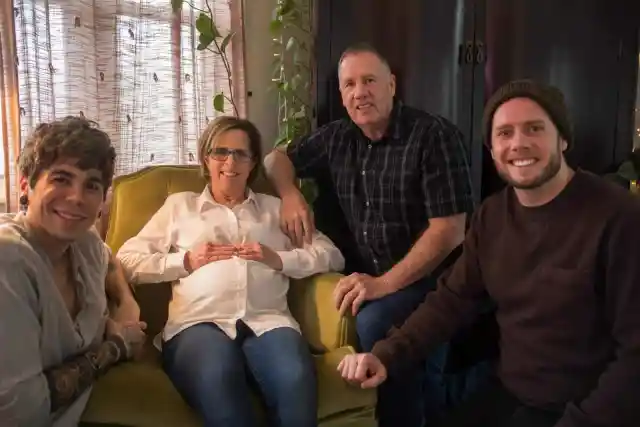
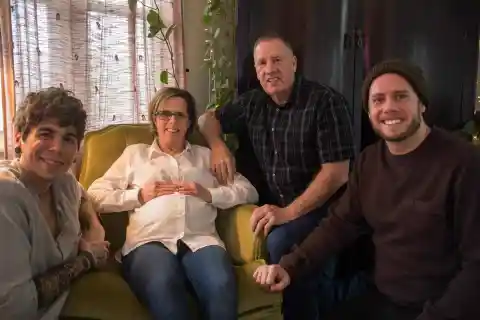
But the truth is that Cecile’s case was very, very special. Although it is technically possible to do what she did, only a handful of women her age are able to do it. There have been cases of even older women carrying children, but they were also in tip-top shape. Matthew and Elliot were extremely lucky to have such a healthy and supportive mother by their side, and for that, they will always be grateful.
Not Only in Movies
We have seen this before on TV. Remember when Phoebe carried her brother’s triplets on Friends? Sure, it seemed like a wacky and funny storyline, but it wasn’t so crazy after all. As early as 1987, a woman gave birth to her three grandchildren at the age of 48, and it was the first high-profile case of surrogacy in the world, which triggered off a wave of debates everywhere.
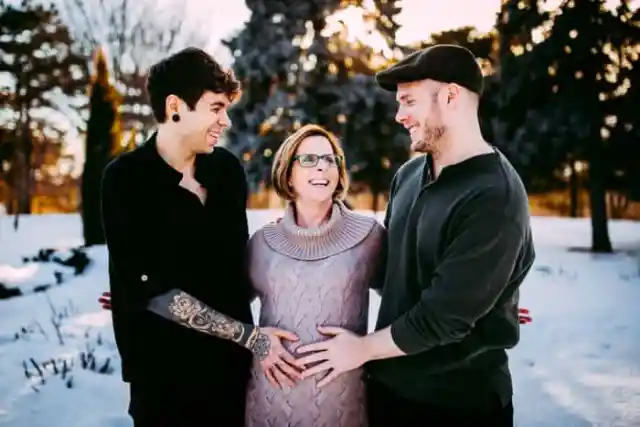
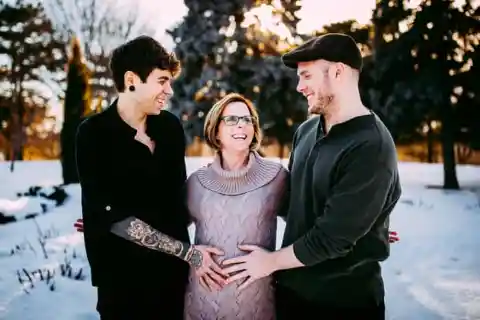
Whether surrogacy is ethical or not is an issue that has been discussed for many, many years, although nowadays it has been much more normalized. Now, it is not surprising to see a grandmother carrying her own grandchildren, thanks to the advancements of science. However, the older the surrogate is, the higher the health risks that come with it, and that was something that Matthew’s family had to seriously consider.
The Risks
Although there have mostly been happy endings to these stories, being a surrogate past your fertility years can be potentially dangerous. Such was the case of Pamela Butler, who gave birth to her own grandson at age 57. She had to go through four rounds of in vitro fertilization (IVF) treatment, and once she finally got pregnant, the problems began. She had to get a C-section at seven and a half months, and the baby weighed 2.16 pounds only.
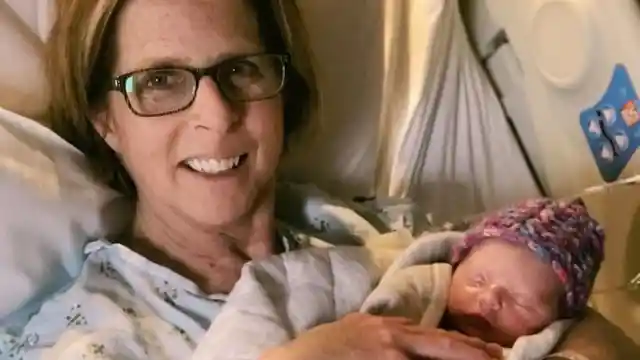
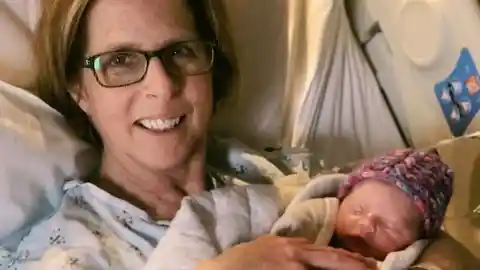
Blood clots and pulmonary problems are some of the risks associated with older surrogates, as well as the increased chance of requiring a C-section. Cecile, however, didn’t hesitate for a second and wanted to get it started right away. Sure, she was warned about the risk, but what isn’t risky these days anyway? All she wanted was to give her son the same joy he gave her when he was born, so they started the IVF treatment straight away.
How It Happened
Elliot and Matthew had the surrogate, who happened to be an older woman who wasn’t fertile anymore. That meant that they also had to find an egg donor so that the fertilized egg could be implanted in Cecile’s womb. Luck was on their side once again, because Elliot’s sister, Lea Yribe, donated her eggs to the couple. The egg was fertilized with Matthew’s sperm, and the embryo was ready to be transferred to Cecile.
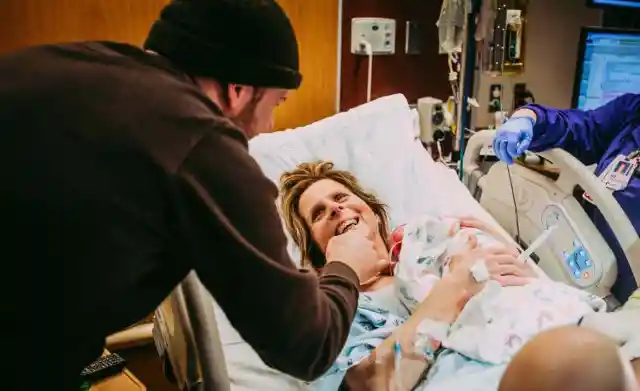
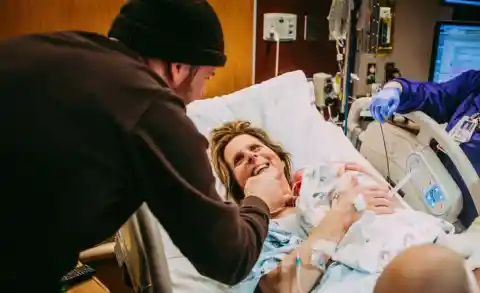
Just doing this process once is extremely expensive, and not at all guaranteed. Some couples have to do it several times until they finally get pregnant, which can end up costing a ridiculous amount of money. Retrieving an egg from a woman, fertilizing it, and implanting it is complicated, and each try costs around $12,000. But the lucky couple only had to do it once, thanks to the almighty Cecile, who got pregnant on the first try.
Bumps In The Road
Thankfully, getting Cecile pregnant was fairly easy and came with no complications. But the couple had to face obstacles outside the pregnancy because, sadly, being a same-sex couple on this day and age still comes with much prejudice and discrimination. Before they decided to become parents, Matthew had been fired from his job because he was gay, which delayed their plans to start a family.


He worked at a private Catholic high school in Omaha as an English teacher and speech coach, but when he informed the school authorities that he was going to get married to Elliot, they cut him loose. The LGBT+ community was outraged, and a petition against the school’s actions got over 100,000 signatures. Eventually, Matthew got a job at a different school, and the couple built their life back together.
The Law Of The Land
You would think that this issue would be over in 2019, but in reality, many states don’t even have laws that prohibit discrimination based on sexual orientation. This means that you can be fired from your job, or not allowed to enter a specific place because of your sexuality. In Nebraska, for example, all bills attempting to amend this were rejected. It’s safe to say that queer couples in this state have to face many obstacles to live their lives in peace and with equal rights.
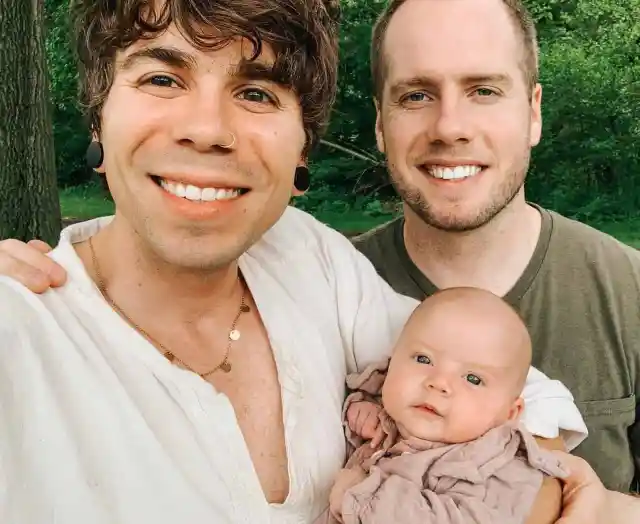
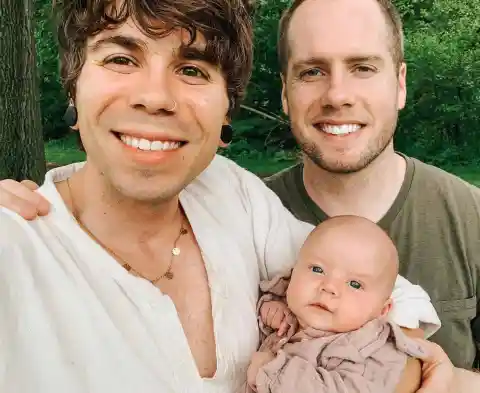
Another problem comes with IVF. As we’ve stated before, it is an extremely expensive process, and only some health insurance providers offer coverage. This coverage, of course, is rarely full. But the biggest problem regarding IVF is that coverage is sometimes offered only to heterosexual couples, making it impossible for same-sex couples to gain access to such treatment if they don’t have the necessary funds.
The Price Of Happiness
Elliot and Matthew had been saving up for years, long before they actually decided to actively seek a baby. They knew the obstacles they would have in their path as a same-sex couple, and one of them would be money. Although they were very lucky and Cecile got pregnant in the first try, they still had to cover an incredible amount of expenses before and after the birth of their baby.
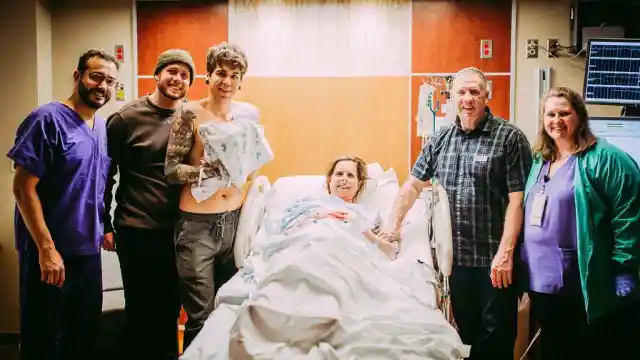
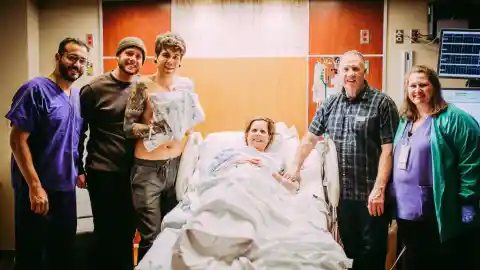
Couples like them usually also have to pay the cost of obtaining an egg, but Elliot’s sister did it for free. However, Cecile’s insurance didn’t cover any costs associated with the pregnancy and the birth of her granddaughter. Only when a woman is carrying her own biological child is she entitled to insurance coverage, and even then, it’s not full. All in all, they had to pay around $40,000.
Open To The Unknown
Even after investing all that money and time, some couples don’t ever get a baby. In Elliot and Matthew’s case, not only did they have to save up a big load of cash, but they also had to mentally prepare themselves for whatever that was to come. Since Cecile was an older surrogate, their costs could be even higher if there were to be any complications with the pregnancy.
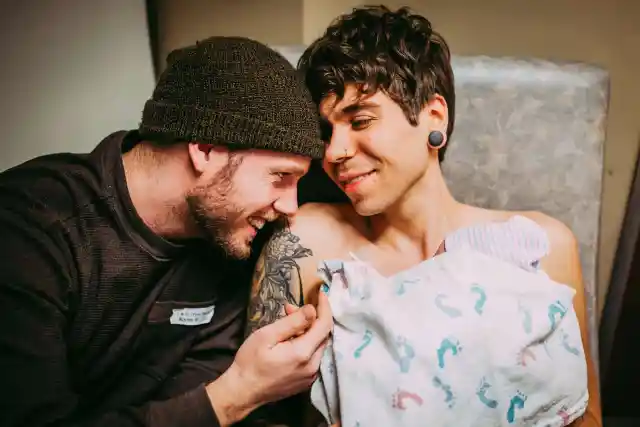

“Because Matthew’s mom was doing something so innovative and new — and she’s an older gestational carrier — any moment could become a huge financial situation,” Said Elliot.
And then, there was the problem with getting Lea’s eggs, which isn’t as easy as you’d think…
Say Yes To The Eggs
Lea, Elliot’s sister, had already told them that she’d be happy to help with anything they needed, and donating her eggs wouldn’t be an exception. But what she didn’t know was how complicated the process would actually be. When men donate their sperm it’s a very easy job, but that’s not the same for women. After the sperm donation is done, it has to be frozen and quarantined for six months in order to be tested for HIV and other diseases, but the man’s job is already done.


In the case of women, it’s completely different. For the embryos to be viable -meaning, potentially healthy- the woman has to be younger than 30. Luckily, Lea was 25 at the time. Before the extraction is performed, the woman has to get shots every single day to stimulate her ovaries. About her experience, Lea said:
“I definitely knew there were going to be shots every day, but it was kind of stressful — you have to do it at the same time every day, which is tough when you have two kids running around. It took a toll on me. But in the end it wasn’t too bad. And it did make me feel for all the couples who have to go through this.”
The Fertilization Process
After getting all the necessary shots, the doctors retrieved two dozen eggs from Lea. Only eleven were fertilized, and seven developed into fertilized embryos. From these numbers, you can safely guess that the success rate is pretty low, and that’s why many couples have to do it more than once. Couples can also get the embryos screened for genetic diseases, to see whether they would develop into healthy babies.
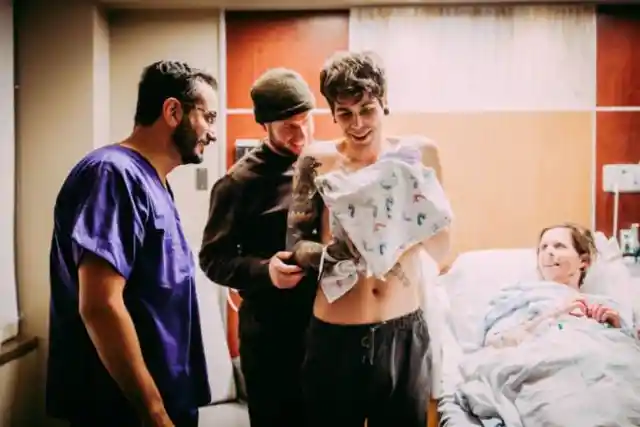
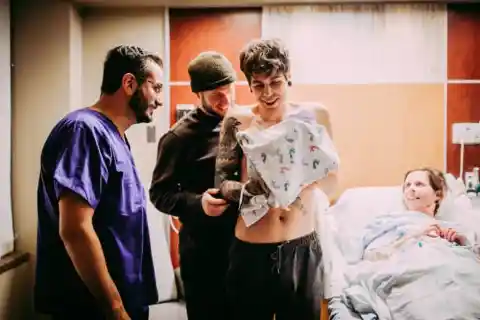
Of course, that means more money is involved. The test left Matthew and Elliot with only three viable embryos. This is the point at which IVF becomes controversial because the parents get to choose which embryos should be implanted in the surrogate. Through the process, you find out the sex of the embryos, and many couples don’t feel comfortable choosing an embryo based on its gender. For Matthew and Elliot, however, the choice wasn’t so difficult.
Playing God
Matthew said in an interview:
“You can find out the sex in that process. I’m not a super religious person, but you do feel like you’re playing God. Like, am I choosing too much?”
Because they didn’t want to make a choice based on gender, they told the doctors to pick the healthiest embryo for implantation. What they didn’t know, however, was that all of them were female, so they never had a choice, to begin with.
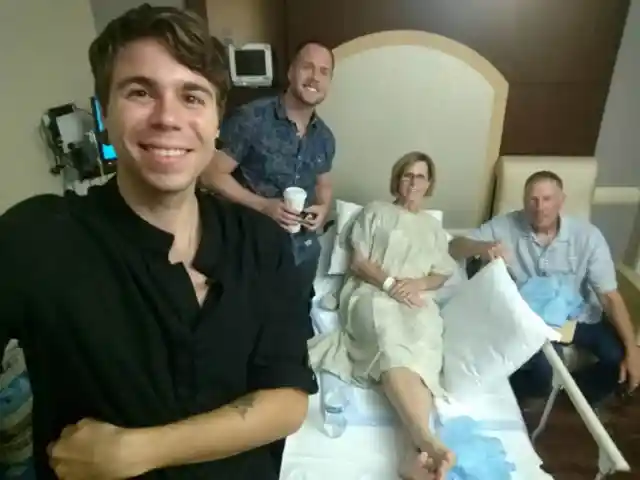

The healthiest one was transferred to Cecile, and the other two were kept frozen for whenever the couple felt like becoming parents again. So their fate was already written because they had the possibility of having three daughters in the future. The idea overjoyed them because they had always dreamed of having a baby girl. Also, their babies would be related to both of them, because it was Elliot’s sister who donated her eggs. Everything was working out for these soon-to-be parents.
Making It Happen
With the embryo ready, doctors put Cecile on estrogen, which made her get her period again – how strange is that? Soon, she was ready to get pregnant once again. What many couples do in these cases is to implant several embryos at once to increase their chances of getting pregnant, but this sometimes results in multiple pregnancies, which is not what the couple wanted.


Multiple pregnancies are always riskier, especially for an older person. A 61-year-old with three babies in her uterus would have a very high risk of hypertension and preeclampsia, which could be very, very bad. So, they took a chance with just one embryo and had to wait two weeks to see if there were any positive results.
The Moment Of Truth
“I was nervous. They ended up with really good embryos — if the first one didn’t take, I didn’t want them to waste the others on me, due to my age.” Cecile said.
The couple couldn’t wait two weeks to get the results, so they got an over-the-counter pregnancy test five days after the transfer. After taking it, Cecile gave her son the sad news that she wasn’t pregnant. But when Matthew grabbed the stick to see for himself, he noticed a very small little pink line. This meant that it was actually happening.
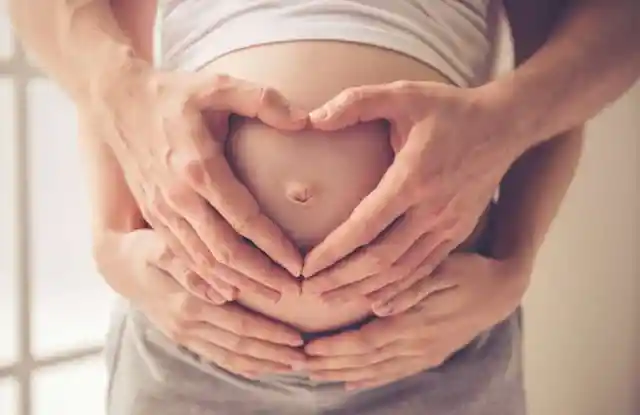
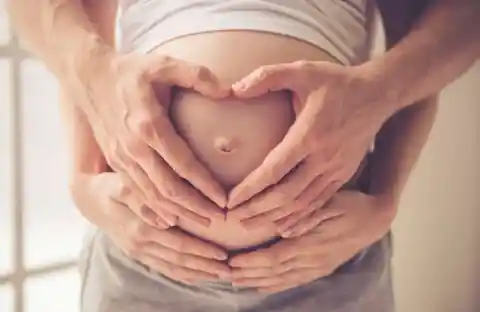
Just to make sure, Cecile did another test, and this time, it showed two pink lines, which meant she was definitely pregnant. It was really happening; their dream was going to come true nine months later. Still, Cecile had to navigate through a pregnancy, which at her age, wouldn’t be easy. With all the risks she had been warned about, she had to be very careful and take care of her health to make it work.
Easy Peasy
Despite all the warnings about the possible health risks associated with pregnancy at her age, Cecile had no problem whatsoever during gestation. In fact, compared to her previous pregnancies, which happened when she was in her twenties, this one felt like a walk in the park. Of course, it came with the usual symptoms, like morning sickness and shortness of breath, but it was still easier than before.


“Actually, it was almost easier. Because I’m older, my diet’s been easier to control, and I didn’t have the responsibility of other children. Just this pregnancy,” She said in an interview.
She had all the time in the world to focus on bringing a healthy baby into the world, so in that sense, being an older surrogate was an advantage. But was it easy to deal with people staring at a 61-year-old pregnant woman?
Repercussions
Imagine going to the obstetrician and seeing a pregnant woman in her sixties sitting beside you in the waiting room – wouldn’t you be surprised? Of course, Cecile and her family had to navigate the pregnancy among shocked faces and people in disbelief, as Kirk, Cecile’s husband, explained in an interview.
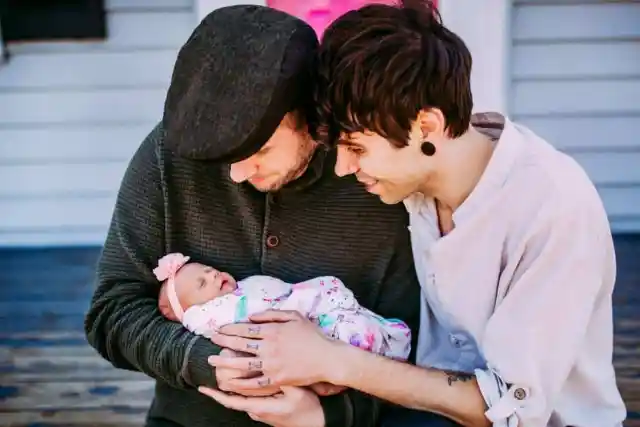
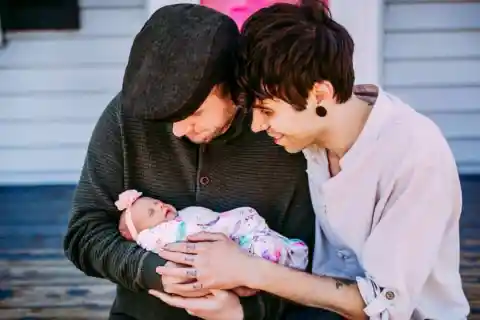
“When we were sitting in the clinic with the two boys, and they’d call out ‘Eledge’ and all four of us got up to go. Other people in the waiting room would just stare, trying to figure out the dynamic of this whole thing”, Kirk explained.
Whenever Cecile showed up at the clinic, she would be treated like a celebrity. People wanted to come and see her miraculous pregnant belly and ask her about her experience, which the family really enjoyed. But sometimes, people’s questions and comments weren’t very nice…
Controversy
We have a woman carrying her son’s child, right? Well, some people even took it as far as saying that it was a form of incest. But Matthew and Elliot never took offense and understood that people’s questions and comments came from a place of curiosity and even ignorance, and they were always ready to answer everyone’s questions. For Cecile, this was a humbling experience.
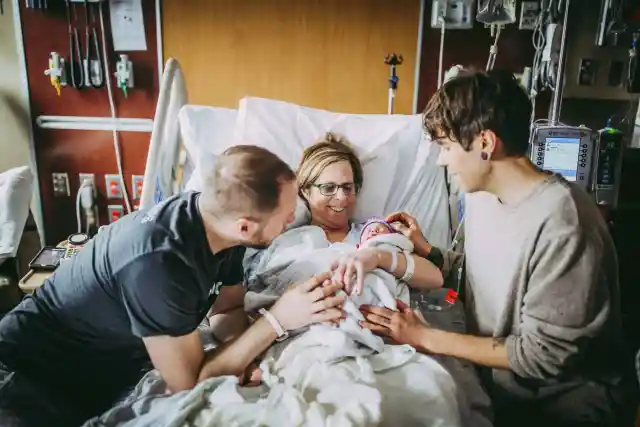
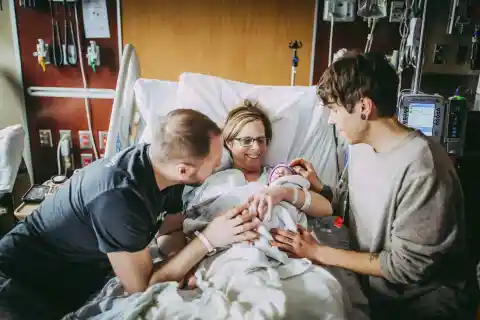
“People didn’t understand at first, but once they do, they’re ridiculously supportive — they think it’s radical and amazing. They’re really inspired by my mom,” said Matthew.
When people saw how selfless and generous Cecile’s actions were, they instantly became supportive. What she did for her son and his husband was an act of love, which inspired many people to do the same for their loved ones.
The Delivery
After a pregnancy with no complications, it was time for Cecile to give birth and finally make her son’s dream come true. When women are over the age of 35, age at which the pregnancy is considered high risk, a C-section is usually required, which is not the ideal way to deliver a baby. Luckily for the family, Cecile didn’t need one. And on March 25, the moment that everyone was waiting for finally happened.
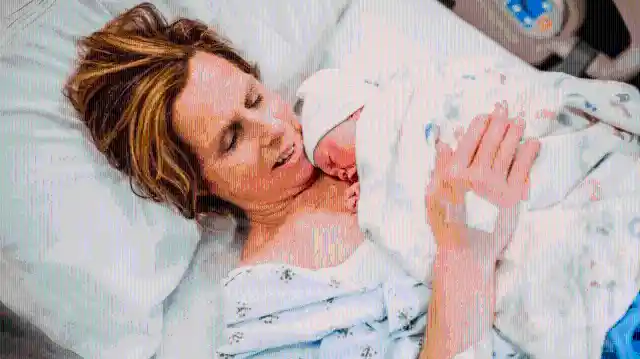

At six in the morning, Cecile gave birth to Elliot and Matthew’s first daughter, Uma Louise Dougherty-Eledge. The sweet little girl weighed 5 pounds and 13 ounces, a perfectly healthy weight. After birth, Cecile said she felt fabulous, and the family was ecstatic. Still, there were certain legal issues the family had to work out. Since Cecile physically gave birth to Uma, she would be considered the mother. How could the couple deal with that?
Legal Consequences
Living in Nebraska as a gay couple is quite a challenge. Now, this challenge becomes even more difficult when a child is involved. After Matthew was fired for being gay, the couple was worried about what the repercussions of having a baby together would be. What many people suggested was that they move to another state where the law is more accepting of same-sex couples.
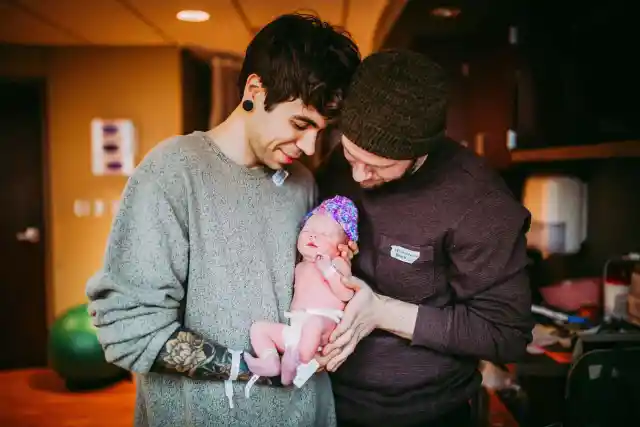

However, the couple decided to stay in Nebraska to be close to their family. About their decision, Matthew said:
“Politically, things haven’t always been in our favor here. Elliot and I thought this wasn’t necessarily a place to raise a family as a gay couple, but we value family so much — here, we have a close-knit community. And that makes it a really good place to live.”
So how did they work around their parental rights?
Uma’s Parents
Because the legal system hasn’t fully adapted to surrogacy, there are some legal loopholes and contradictions that couples have to deal with, especially when they are homosexual.
“It’s kind of embarrassing. My mom and I are legally Uma’s parents”, said Matthew.
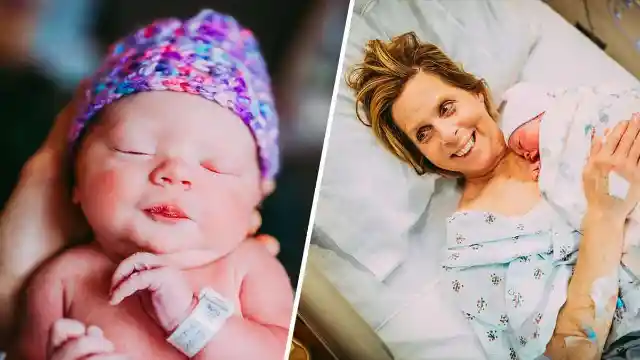
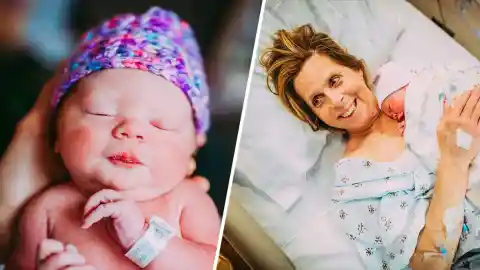
Yes, you read that right. In Nebraska, the sperm donor is considered the father, and the person who delivers the child is considered the mother. Their biological connections are not taken into consideration, which is a major problem: a mother and her son have a baby together! Uma’s birth certificate is something Elliot and Matthew would like to burn – and we feel the same way as well. Elliot couldn’t be included in the birth certificate at all, and his sister couldn’t either, even though she donated her eggs.
What If Something Happened?
Sure, you could argue that a birth certificate is just a piece of paper and that what matters is who raises Uma, but overlooking the legal repercussions of it is a big mistake. If something were to happen to Matthew, Elliot would not have any parental rights over the baby. The couple will have to face a long legal battle and hopefully, someday they will get the rights that they deserve.
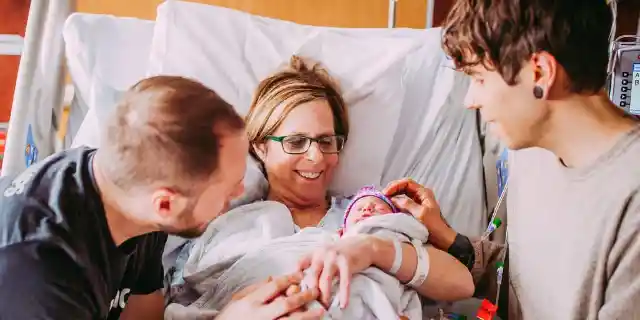
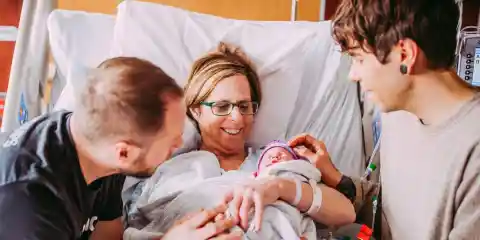
In spite of that, Elliot and Matthew are the happiest they have ever been. After all this time, all the effort they put into making their dream come true, she’s finally here. As Matthew said:
“I’m looking at her — and this has been a two-year process. It was all a theory. But then through creation and creativity and imagination and dreams, she became a thing, a physical thing. That’s when I think I lost it, when I realized she’s no longer a thought, an idea. She’s here! We did this. We all did this together.”